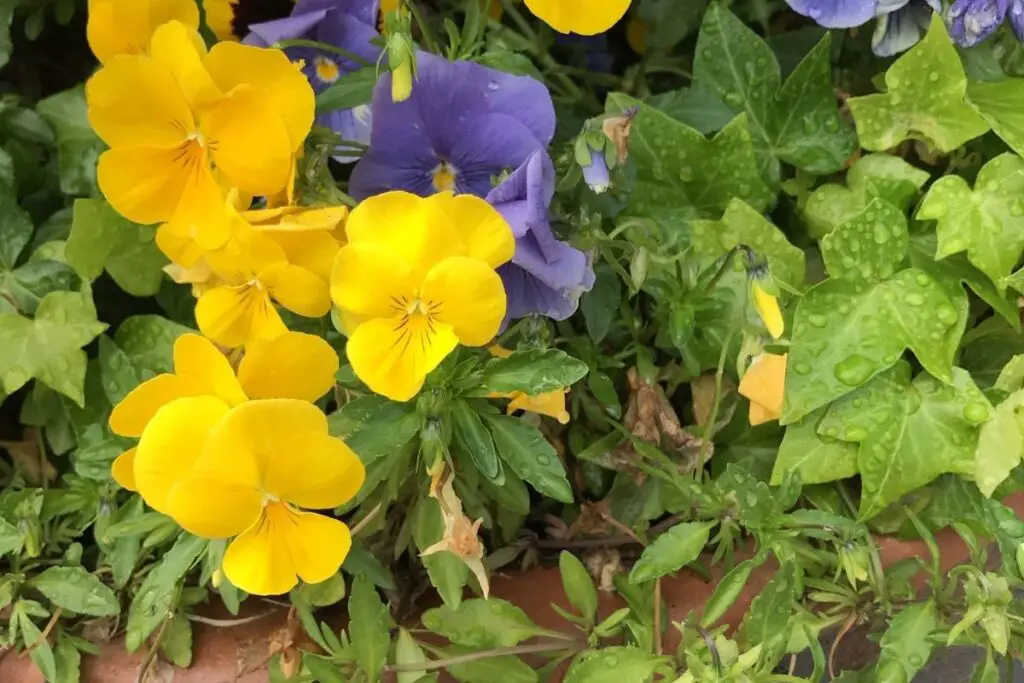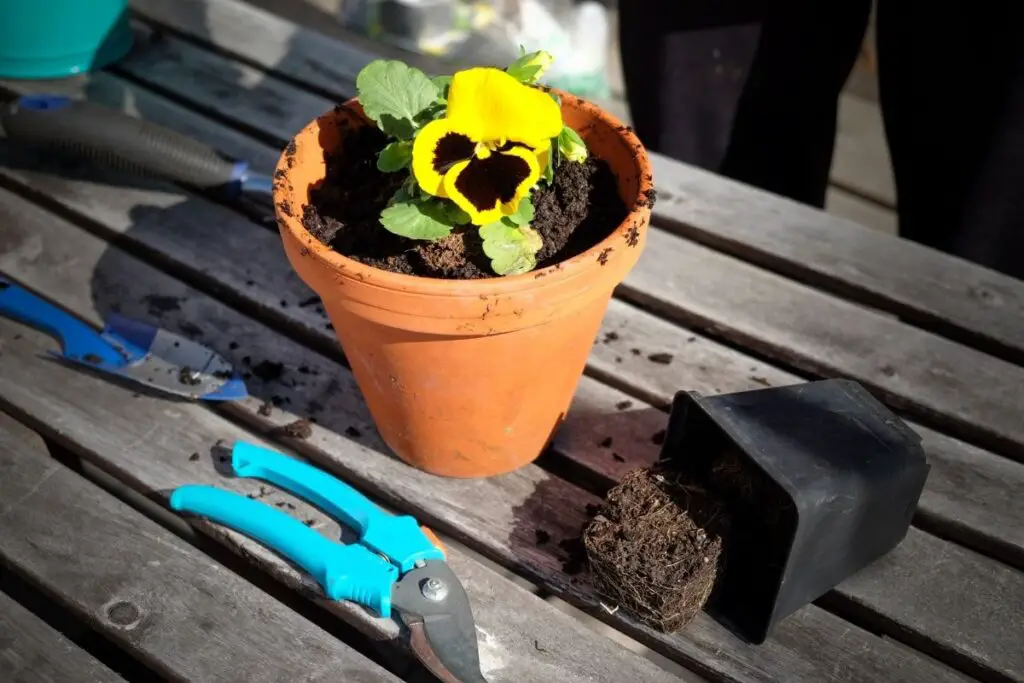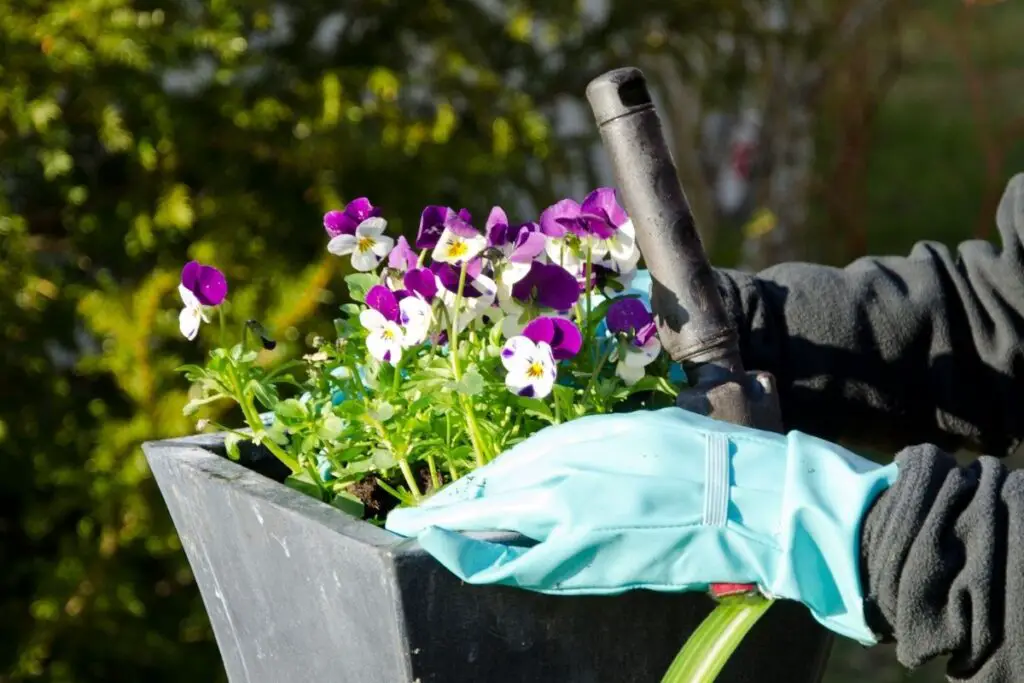Pansies are popular home garden plants related to the violas family and come in various colors. Pansies thrive in full sun, and cool temperatures remain hardy through winter and spring in warmer climates.
They provide lovely blooms at a time when most other flowers have died back for the season. Pansies can be grown in winters; they can tolerate low temperatures and thrive well in cool weather.
But the important question is how much cold can pansies tolerate? Let’s find out.
Pansies grow best at a temperature range of 45-65°F, but they can withstand temperatures as low as -10°F. The foliage will survive at low temperatures, but the flowers will start to wilt when the temperature drops below 25°F. It is best to protect the plant when the temperature drops below 20°F.
This article will explain how cold it can tolerate and the ideal temperature for growing pansies in winter.
Also, we will discuss how cold temperature affects the pansies and the care tips to prepare them for winters.

Can pansies survive winters?
Pansies can survive winters. They are hardy plants that will survive a frost and even a hard freeze for a while. The flowers may wither due to low temperatures, but the plant will survive.
The future buds are protected down in the crown of the foliage and will emerge when the surrounding temperature rises.
When the temperature falls below 10°F for several hours, this is an extreme condition for pansies. The roots will not be able to absorb water from the frozen soil.
Frozen soil and dry wind can kill the pansies, even though the plants are healthy. Snowfall helps the pansy beds as it insulates and protects them from the wind.
How much cold can pansies tolerate?
Pansies are not sensitive to cold weather. They can tolerate low temperatures and thrive in cool weather 40-60°F.
Pansies enjoy moderate temperatures. But they don’t do well when the temperatures rise beyond 60-65°F.
They can survive single-digit temperatures, but pansy foliage will wilt and turn grey-green when the air temperature drops below 25°F (-4°C).
This is an average defense to cold weather, and they will bounce back when the warm weather returns.
The plant will survive, but its spring flowers will be severely affected.
Let us now discuss the ideal temperature requirement of pansies.
Minimum temperature
Pansies generally flower until fall, when frost begins to occur regularly.
Even in places where the temperature reaches below the freezing point, pansies continue to bloom throughout the cold months.
Some varieties of pansies continue to grow well in temperatures below freezing, as low as 2-5°F. They produce abundant blooms in cooler temperatures and decrease vigorously as the temperature rises.
Ideal temperature
Temperature influences processes like photosynthesis, transpiration, respiration, germination, and flowering.
Excessive temperature fluctuations can cause stress, inhibit their growth, promote a spindly appearance, and damage their foliage.
Pansies are short-lived perennials that can be grown as biennials or annual depending on the location. Temperature, just a bit over freezing, such as 40°F, is considered ideal for them.
During the day, pansies thrive in temperatures in the high 50°F and low 60°F. So ideal temperature is vital for pansies growth and survival.
Looking for gardening supplies? We have tested 100's of products before recommending them to you guys. Check out our best pick below:
| Image | Gardening Supplies | Best Price? |
|---|---|---|
 Top
Top Top
Top | Raised Garden Bed Kit | Check On Amazon |
 | XLUX Soil Moisture Meter, Plant Water Monitor, Soil Hygrometer Sensor for Gardening, Farming, Indoor and Outdoor Plants, No Batteries Required | No Results |
 Top
Top Top
Top | 82 Pcs Garden Tools Set and Extra Succulent Tools Set | Check On Amazon |
 | Joeys Garden Expandable Garden Hose with 8 Function Hose Nozzle, Lightweight Anti-Kink Flexible Garden Hoses, Extra Strength Fabric with Double Latex Core, (50 FT, Black) | No Results |
 Top
Top Top
Top | Dual Chamber Compost Tumbler | Check On Amazon |
 Top
Top Top
Top | Sunnyglade Plant Stakes | Check On Amazon |
 Top
Top Top
Top | Organic Cold Pressed Neem Seed Oil | Check On Amazon |
 Top
Top Top
Top | Mighty Mint Gallon :-Insect and Pest Control Peppermint Oil | Check On Amazon |
 Top
Top Top
Top | Scotts DiseaseEx Lawn Fungicide | Check On Amazon |
 Top
Top Top
Top | Jacks Classic 20-20-20 All Purpose Fertilizer | Check On Amazon |
 Top
Top Top
Top | 30,000 Seeds Pollinator Attracting Wildflower Mixture | Check On Amazon |
 Top
Top Top
Top | Survival Vegetable Seeds Garden Kit-Over 16,000 Seeds | Check On Amazon |
What are the effects of cold temperature on pansies?

Pansies can survive the extreme cold but up to a specific limit.
Natural factors like air temperature and soil temperature create a drastic effect on pansies. Also, human factors like late fertilization during cold can harm pansies.
Let’s discuss these problems and their solutions briefly.
Air temperature
Cold air temperature freezes the cells in the plant, causing damage and interruptions in the pathways for water and nutrients.
When the temperature levels drop below 25°F, pansies start putting up their guard to protect themselves. The leaves get discolored and start wilting.
Pansies try to save themselves from the cold temperatures with these mechanisms. And it doesn’t indicate that the plants are dying.
Solution
- You can shield your plant with a dry winter mulch. Apply 2-4 inches thick pine straw over your garden bed. Gently remove the pine straw after wintertime. This helps to trap the heat in the soil and reduces its exposure to cold wind.
- You can also use frost protection blankets to cover your plants.
- Choose healthy pansy seedlings. Healthy plants rapidly grow their root system which is vital for winter survival.
Soil temperature
Soil temperature is often considered a crucial factor for wilting pansies as compared to air temperature.
The soil’s temperature while planting flowers will determine the future health of the plant.
If the soil temperature is below 45°F, your pansies’ roots will shut down, and flowering will be sparse.
In such cases, the soil freezes around pansies’ root balls which does not let the plant roots absorb water and nutrients from the soil properly.
The plant then becomes more susceptible to frost damage and diseases. It can also cause dehydration in pansies, and they will undoubtedly die.
Solution
- Test the soil before planting. The soil temperature should be between 45-70°F for successful planting.
- Soil preparation is vital, so you should reinforce the flower bed with 3 to 4 inches of organic matter.
Wrong fertilization
Pansies do not have the same fertilization requirement throughout the year. The different seasons demand different kinds of fertilizers.
Fertilizing with a slow-release fertilizer during winter or fall can lead to root burn and other damages to your pansies.
A slow-release fertilizer will work well during the summer season as the pansies will not face any problem absorbing the nutrients that get released into the soil slowly.
Solution
Instead of opting for a slow-release fertilizer that contains an excess of Nitrogen, you can apply a well-balanced liquid fertilizer during fall. This will help your pansies survive winter.
How to care for pansies during winter?

Pansy winter care begins when you first plant them in the fall. You have to provide good care and plant them at the right time to ensure that they can persist throughout the winter.
The winter care tips will assure the healthiest plants and most prolific blooms at winter’s ends. The winter care tips are:
- Proper planting of pansies
- Choose healthy plants
- Check the soil level
- Ensure good drainage
- Mulching
- Watering
- Deadheading
Let’s discuss these points in detail.
Proper planting of pansies
Plant your pansies early in autumn to give their roots a head start. If the roots are strong, the pansies will be able to survive the cold better.
Choose healthy pansies
Select the healthiest pansies with strong stems and buds and no blooms. Healthy pansies will not only grow and bloom well but also tolerate the cold efficiently.
If you want your pansies to tolerate the cold, you need to get strong pansies with strong roots.
You can use an organic slow-release starter fertilizer.
Consider the soil
If you don’t want to stress your pansies, you should dig the soil as deep as it was in the nurseries. It will help the pansies adjust better.
Whereas, planting the pansies deeper than that can cause stress, especially during the cold.
Sound drainage
Pansies do not prefer soggy soil. If you are using regular garden soil or clayey soil, it will retain more water than required, making the soil waterlogged.
Therefore, you should make sure that the soil supports sound drainage.
You must prepare the soil bed with the right type of soil before you plant the pansies. Pansies prefer rich loamy soil with good moisture retention capacity.
Mulching
Winter months are generally arid, and mulching protects the plant’s roots by adding moisture.
Apply an inch or two of straw mulch at the planting site, be careful to keep the mulch away from the main stems, as this can encourage soil-borne diseases.
Before the first frost, mulch with another inch or two of straw, but cover the stems this time.
Watering
Many flowering plants don’t need water in the winter, but these spring bloomers need water.
They are developing root systems and stems and can even produce flowers until the temperature drops below 25°F.
Even if cold wilts their leaves, they need to stay hydrated to bloom again in spring. Add an inch of water when the soil feels dry.
Watering them before the arrival of a deep freeze is necessary because the ground will become hard, and the roots can no longer draw up water from the soil.
Deadheading
Remove the old blooms and pinch off the leggy stems and damaged leaves. It will allow your pansies to produce roots and prepare them for spring.
If the temperature dips below 25°F, the plant usually goes dormant at that time. You should stop deadheading your pansies at that time.
Final words
- Pansies are winter hardy plants that survive well in extreme cold and frost.
- They cannot survive well when temperatures drop below 25°F, and they wilt and turn greyish.
- Pansies grow best when temperatures remain between 45-65°F.
- A change in soil temperature and air temperature can cause poor survival of pansies in the cold.
- Fertilizers rich in nitrogen can harm pansies in the cold.
- You can keep your plants healthy by mulching, proper watering, and timely deadheading during winter.
Ref: The University of Arkansas, Britannica, Utah State University, Wikipedia, The University of Georgia, The Pennsylvania State University, The Royal Horticultural Society.

